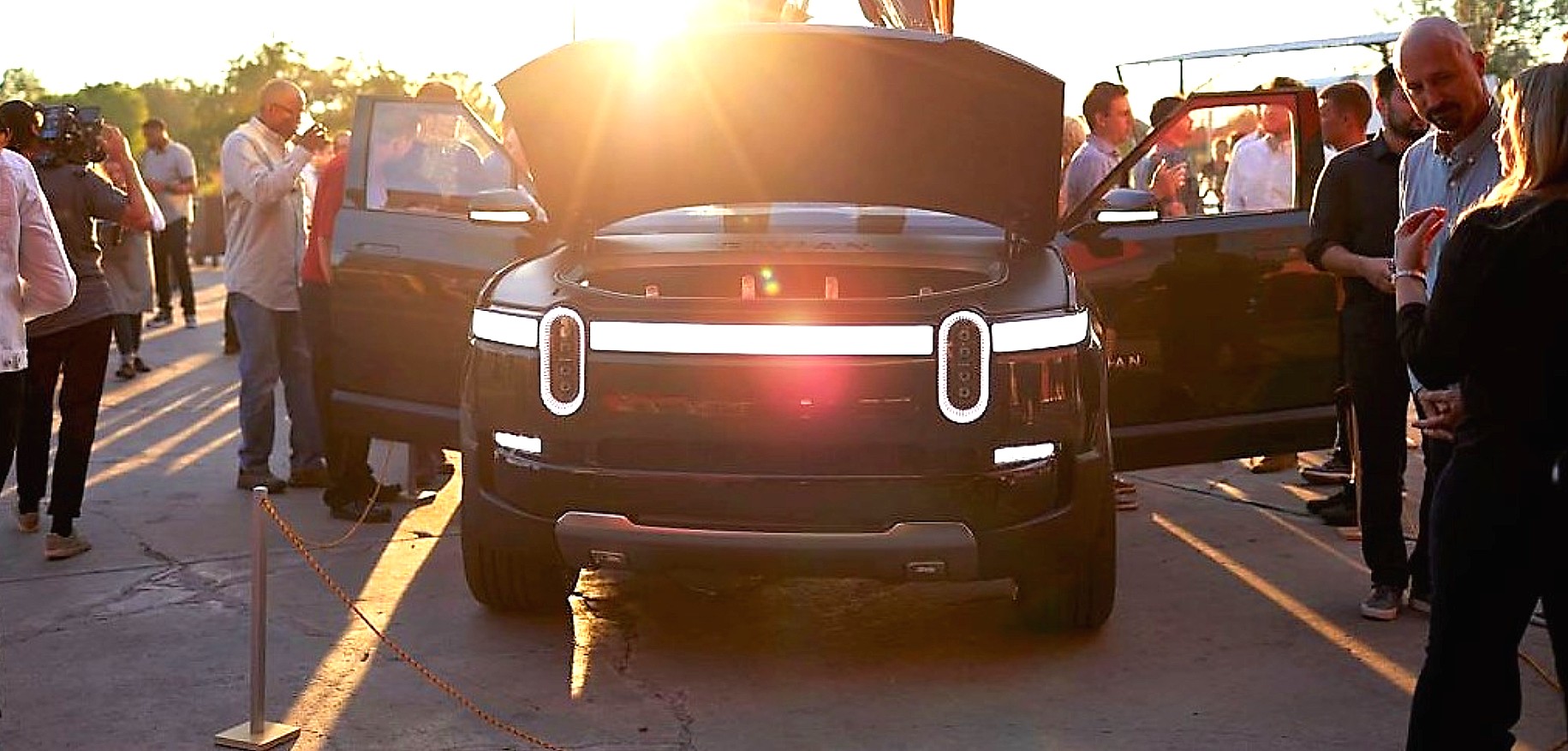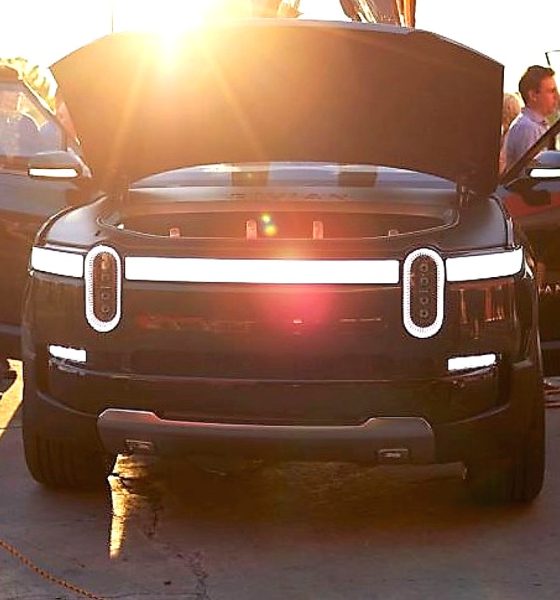

News
Rivian’s community growth is driven by a focus on sustainability
Rivian only officially entered the auto manufacturing scene last November, but you’d hardly know it by the headway the company has made in terms of branding and enthusiasm for its upcoming all-electric R1T pickup truck and R1S SUV. The startup’s flurry of marketing activity in the months since launching is largely to thank for the growing, nascent community. However, Rivian now has its sights set on earning even more respect from the clean energy crowd that’s already excited about electric vehicles via energy storage projects.
Last week, Rivian announced a new partnership with rock climber Alex Honnold and the Honnold Foundation to use the car maker’s used vehicle batteries for microgrid energy storage in underserved areas. The first project will take place in Adjuntas, Puerto Rico working with Casa Pueblo, a local organization committed transitioning their city’s energy grid to solar power. In the wake of Hurricane Maria, the Adjuntas community is ready for sustainable, independent energy sources, and Rivan’s batteries have substantial capacity – even after their vehicle life cycle is expended – to help with that transition.
The batteries Rivan is designing for its vehicles are purpose-built to have second-life storage applications, and the Adjuntas microgrid project will enable the company to implement the first steps of this broader plan. While the first R1T and R1S vehicles have yet to be delivered to patiently awaiting customers, spending time on environmentally-focused projects has been part of Rivian’s plans since its inception. “It’s the central motivation for the business,” CEO RJ Scaringe explained in a recently live streamed conversation about the joint microgrid initiative.
Many thanks to everyone who traveled near and far to be with us Saturday night in Denver. Such an amazing community is forming. To @casapuebloorg , @honnoldfound , @AlexHonnold, @RichRoll – exciting things to come . See more https://t.co/0XXhEqf5wk pic.twitter.com/yjjAThdzen
— Rivian (@Rivian) June 18, 2019
Scaringe is a self-described car enthusiast, but as his awareness and concern for the environmental issues surrounding gas-powered vehicles grew, he eventually made the decision to start a new car company that matched his values.
“The [cars] that I really loved were simultaneously making the planet worse, whether it’s geopolitical or air quality or climate change, and it really bothered me,” Scaringe admitted. “So…the way I thought I could have the most impact was to start a company. In starting Rivian, the goal was to create products that are exciting and built with passion and deliver real performance, but at the same time are deeply sustainable… The decisions we make as a company are absolutely made from the vantage point of how do we have the most impact.”
Alongside energy projects, Rivian has also made several appearances at trade shows, auto shows, and outdoor vendor events to continue building a network of business and consumer relationships that grow its community. New features and options have been announced as well, such as vehicle-to-vehicle charging and a portable kitchen set for the R1T gear tunnel, all of which have helped keep up enthusiasm for the company.

The attention Rivian has already garnered for the high-tech and performance stats of its upcoming R1T truck and R1S SUV is well deserved. Both vehicles have four electric motors with 750-800 total horsepower that can reach highway speeds in around 3 seconds, and 147 kW of independent power at each wheel also provides for torque vectoring. Rivian’s high-density battery packs have a thermal control system that adapts according to charging and driving behavior, and they’re tightly encased using advanced materials science to be capable of wading up to three feet of water. The 180 kWh “megapack” option is expected to give around 400 miles of range.
Rivian already has plenty to offer future customers as an all-electric car manufacturer full of innovative ideas, and their new sustainability initiative adds to the startup’s promising outlook. Production is slated for 2020 and pre-orders are available on the official website.

News
Tesla FSD fleet is nearing 7 billion total miles, including 2.5 billion city miles
As can be seen on Tesla’s official FSD webpage, vehicles equipped with the system have now navigated over 6.99 billion miles.

Tesla’s Full Self-Driving (Supervised) fleet is closing in on almost 7 billion total miles driven, as per data posted by the company on its official FSD webpage.
These figures hint at the massive scale of data fueling Tesla’s rapid FSD improvements, which have been quite notable as of late.
FSD mileage milestones
As can be seen on Tesla’s official FSD webpage, vehicles equipped with the system have now navigated over 6.99 billion miles. Tesla owner and avid FSD tester Whole Mars Catalog also shared a screenshot indicating that from the nearly 7 billion miles traveled by the FSD fleet, more than 2.5 billion miles were driven inside cities.
City miles are particularly valuable for complex urban scenarios like unprotected turns, pedestrian interactions, and traffic lights. This is also the difference-maker for FSD, as only complex solutions, such as Waymo’s self-driving taxis, operate similarly on inner-city streets. And even then, incidents such as the San Francisco blackouts have proven challenging for sensor-rich vehicles like Waymos.
Tesla’s data edge
Tesla has a number of advantages in the autonomous vehicle sector, one of which is the size of its fleet and the number of vehicles training FSD on real-world roads. Tesla’s nearly 7 billion FSD miles then allow the company to roll out updates that make its vehicles behave like they are being driven by experienced drivers, even if they are operating on their own.
So notable are Tesla’s improvements to FSD that NVIDIA Director of Robotics Jim Fan, after experiencing FSD v14, noted that the system is the first AI that passes what he described as a “Physical Turing Test.”
“Despite knowing exactly how robot learning works, I still find it magical watching the steering wheel turn by itself. First it feels surreal, next it becomes routine. Then, like the smartphone, taking it away actively hurts. This is how humanity gets rewired and glued to god-like technologies,” Fan wrote in a post on X.
News
Tesla starts showing how FSD will change lives in Europe
Local officials tested the system on narrow country roads and were impressed by FSD’s smooth, human-like driving, with some calling the service a game-changer for everyday life in areas that are far from urban centers.

Tesla has launched Europe’s first public shuttle service using Full Self-Driving (Supervised) in the rural Eifelkreis Bitburg-Prüm region of Germany, demonstrating how the technology can restore independence and mobility for people who struggle with limited transport options.
Local officials tested the system on narrow country roads and were impressed by FSD’s smooth, human-like driving, with some calling the service a game-changer for everyday life in areas that are far from urban centers.
Officials see real impact on rural residents
Arzfeld Mayor Johannes Kuhl and District Administrator Andreas Kruppert personally tested the Tesla shuttle service. This allowed them to see just how well FSD navigated winding lanes and rural roads confidently. Kruppert said, “Autonomous driving sounds like science fiction to many, but we simply see here that it works totally well in rural regions too.” Kuhl, for his part, also noted that FSD “feels like a very experienced driver.”
The pilot complements the area’s “Citizen Bus” program, which provides on-demand rides for elderly residents who can no longer drive themselves. Tesla Europe shared a video of a demonstration of the service, highlighting how FSD gives people their freedom back, even in places where public transport is not as prevalent.
What the Ministry for Economic Affairs and Transport says
Rhineland-Palatinate’s Minister Daniela Schmitt supported the project, praising the collaboration that made this “first of its kind in Europe” possible. As per the ministry, the rural rollout for the service shows FSD’s potential beyond major cities, and it delivers tangible benefits like grocery runs, doctor visits, and social connections for isolated residents.
“Reliable and flexible mobility is especially vital in rural areas. With the launch of a shuttle service using self-driving vehicles (FSD supervised) by Tesla in the Eifelkreis Bitburg-Prüm, an innovative pilot project is now getting underway that complements local community bus services. It is the first project of its kind in Europe.
“The result is a real gain for rural mobility: greater accessibility, more flexibility and tangible benefits for everyday life. A strong signal for innovation, cooperation and future-oriented mobility beyond urban centers,” the ministry wrote in a LinkedIn post.
News
Tesla China quietly posts Robotaxi-related job listing
Tesla China is currently seeking a Low Voltage Electrical Engineer to work on circuit board design for the company’s autonomous vehicles.

Tesla has posted a new job listing in Shanghai explicitly tied to its Robotaxi program, fueling speculation that the company is preparing to launch its dedicated autonomous ride-hailing service in China.
As noted in the listing, Tesla China is currently seeking a Low Voltage Electrical Engineer to work on circuit board design for the company’s autonomous vehicles.
Robotaxi-specific role
The listing, which was shared on social media platform X by industry watcher @tslaming, suggested that Tesla China is looking to fill the role urgently. The job listing itself specifically mentions that the person hired for the role will be working on the Low Voltage Hardware team, which would design the circuit boards that would serve as the nervous system of the Robotaxi.
Key tasks for the role, as indicated in the job listing, include collaboration with PCB layout, firmware, mechanical, program management, and validation teams, among other responsibilities. The role is based in Shanghai.
China Robotaxi launch
China represents a massive potential market for robotaxis, with its dense urban centers and supportive policies in select cities. Tesla has limited permission to roll out FSD in the country, though despite this, its vehicles have been hailed as among the best in the market when it comes to autonomous features. So far, at least, it appears that China supports Tesla’s FSD and Robotaxi rollout.
This was hinted at in November, when Tesla brought the Cybercab to the 8th China International Import Expo (CIIE) in Shanghai, marking the first time that the autonomous two-seater was brought to the Asia-Pacific region. The vehicle, despite not having a release date in China, received a significant amount of interest among the event’s attendees.








